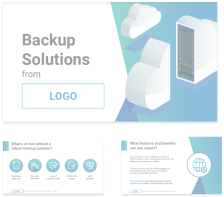MSP Business
Crash Course in SEO for MSPs
As an MSP, you probably don’t spend much time thinking about search engine optimization, or SEO. But the fact is that having at least a working understanding of SEO is essential if you want to market your MSP business effectively on the Web.
And although SEO may seem overly complicated, or even intimidating, the core principles are actually quite simple to master. Below is a crash course in SEO best practices, tailored to the needs of MSP businesses.
Further reading MSP Marketing: How to Start So It Works
What Does SEO Mean?
In a nutshell, SEO refers to techniques and practices that help Web content rank higher in search engine results.
There are many considerations that inform SEO, such as the way you use links and headers, but the single most important is keywords. When a user conducts a search with a particular keyword, websites that contain the keyword will appear at the top of the page (in a manner similar to PPC campaigns. To learn more about these campaigns, check out our Guide to Web Advertising.
When you create content, you want your content to rank as high as possible within search results. This is critical because seventy-five percent of Web users don’t bother looking past the first page of search results. So, if your content doesn’t appear on the first page, it may as well not exist at all, as far as the average Web user is concerned.
Why MSP SEO Matters
The main reasons why SEO matters are straightforward: it helps to ensure that people who are interested in the services you provide or the online content you produce will find your business in their search results.
More specifically, SEO helps to:
- Grow organic traffic to your website, blog, or other digital properties.
- Increase brand awareness.
- Make you stand out from competitors (by ranking higher in search results).
- Generate leads by bringing them to your website.
SEO marketing allows you to achieve all of these goals using just Web content. You could use ads to try to achieve similar objectives, but ads cost money and do not always result in as much engagement with potential customers. Ads may be useful, too, in some cases, for promoting your business, but a well-executed MSP SEO strategy lays the foundation for your overall digital marketing operation.
Getting Started with SEO
As we mentioned before, SEO can appear complicated, but in fact, it’s relatively easy to learn the essentials. The following are the steps to get started with SEO.
Before You Start
Before you start thinking about SEO itself, it’s important to make sure your digital presence as a whole is sound.
Make sure you have addressed the following:
- Define your unique selling proposition (USP). In other words, know which services you want to market and sell, and how they speak to customers’ pain points.
- Ensure your MSP website works well on mobile devices, as well as PCs.
- Host your website with a reliable hosting company.
- Verify your site’s domain authority to get an overall sense of how search engines currently rank your content as a whole.
These steps help ensure that you are prepared to capitalize fully on an SEO campaign.
Select Proper Keywords
Since keywords form the basis for SEO, selecting the right keywords to target is critical. When identifying which keywords make the most sense for your business and marketing goals, consider which search terms most closely align with what your business does and what your customers need.
Then, perform research (using one of the tools listed below) on those search terms. Collect data on search volume, in order to make sure that users are actually performing searches for your terms. Remove from your list any terms that have zero monthly search volume.
At the same time, however, keep in mind that focusing on the highest-volume search terms is not always ideal, because your competitors may already be focusing on those terms. Instead, see if you can identify search terms that have decent volume, but for which there is little good content already published online. Those are the terms where you have the greatest opportunity to make your own content rank highly.
On-Site SEO
The next step is to perform on-site SEO, which means optimizing the content of the actual pages on your website for your MSP SEO purposes. The following chart shows how different elements of a web page are treated by search engines, and how to optimize them.
|
ELEMENT |
DO SEARCH ENGINES ASSESS IT? |
WHY IT'S IMPORTANT |
| URL |
Yes |
It’s used to describe the website or web page to both users and search engines. |
| Page title |
Yes |
Keywords should be at the beginning of the phrase. |
| Page description (meta tag) |
No |
Doesn’t influence search results, but users can see it. Make it captivating for them (and unique for each page). |
| Body content |
Yes |
Search engines scan the text and define whether the content is relevant to the topic stated. |
| Pictures and files |
Yes |
Make sure filenames and alt tags (which are defined in HTML) describe pictures or other files accurately |
| Anchor text of the link |
Yes |
The text should describe the content of the link (instead of being generic, such as "click here"). |
Other ways to optimize content include:
- Optimize for voice search by using very long-tail keywords that provide an immediate answer to a question that someone might search for using voice input or a digital assistant. For example, a keyword such as Are there any MSPs near Bath? is likely to perform better for voice search than MSPs Bath.
- Geo-target your keywords by adding location information to them. For example, instead of targeting a generic keyword such as Managed security services, target London managed security services.
User Experience and SEO
Search engines don’t care only about keywords. They also assess the effectiveness of the overall user experience that your site provides. They will reward you for the following:
- Having clear navigation on your site.
- Having a mobile-friendly site.
- Providing fast page load speeds.
- Offering a custom 404 page.
Further reading MSP Website That Works — 4 Key Points
Proper Content for MSP SEO
Modern search engines also evaluate your content. If you attempt to “game” the system by packing pages full of keywords without providing meaningful content, search engines are unlikely to rank you highly.
Instead, ensure that your content is perceived by search engines as meaningful and relevant. The following practices help:
- Avoid duplicate content. In other words, don’t have multiple pages that contain the same material. Some content overlap between pages is fine, but pages that are nearly identical are not.
- Create diverse content. Don’t stick only with text; weave graphics, videos, and so on into your text, where appropriate.
- Make sure your content offers real value to readers. This will help spur more links to your site, which will in turn lead to higher rankings.
- Use internal links to connect pages within your site to one another.
Check out these marketing templates that we created to help MSPs sell Microsoft 365 as a managed service:

Off-Site SEO
It’s not only the material on your site itself that impacts SEO. External factors matter, too. Optimizing these factors is known as off-site SEO.
Backlinks
Backlinks are links from external sites to your site. The more backlinks there are to your site from other sites that rank highly, the higher your own site will rank.
While you can’t force reputable external sites to create links to your site, you can encourage backlinking through the following strategies:
- Creating guest posts on external sites and linking the posts (or a bio that accompanies them) back to your site.
- Social media marketing, which can generate links to your site from reputable social media platforms, as well as encourage social media users to create links from sites they control.
- Fight spam. Just as links from high-quality sites are rewarded, links from spammy sites can lead to lower page rankings. Avoid linking to your site from sites that a search engine is likely to see as irrelevant
Behavioral Analysis
In order to assess the effectiveness of your MSP SEO strategy, you should analyze the behavior of users on your site. Collect data on which links users click to visit your site, how long they spend, how many visitors return, and which parts of the site are accessed most frequently.
By tracking this data over time, you can assess how changes to your SEO strategy impact performance.
MSP SEO tools
The SEO steps described above are easier to execute if you employ tools designed to help with SEO. Here are a few leading options:
- Google Search Console (free).
- Google Keyword Planner.
- SEMRush (from $99/month).
- KWFinder (from $29/month).
Further reading MSP Marketing Tools: Top 7 Free Picks for Powerful Marketing
What Not to Do for SEO
As a final note in this MSP SEO crash course, here’s a list of practices to avoid:
- Creating content that is not relevant to your business or your services.
- Hiding content on your site by avoiding linking to it.
- Cloaking, which means presenting content to the search engine spider that is different from that presented to a live user.
- Using overly long headings or titles on a Web page. The recommended length is between 60 and 150 characters. Beyond this, headings and titles become harder to read, and search engines may rank you lower based on them.
- Stuffing your site with ads.
- Keyword stuffing, or placing an unreasonable number of keywords into the text and meta tags.
- Creating duplicate content.
- Creating blank pages, or pages with almost no content.
- Including irrelevant redirects to other pages on your site or other websites. In general, avoid redirects, unless there is truly no other way to achieve the desired navigation.
- Generating fake comments and reviews. Search engines (not to mention human users) can often detect these.
- Using overly complex navigation.
Conclusion
If you’ve read this far, congratulations; you’ve learned the basics of SEO. This is only the tip of the iceberg; there is much more that you could choose to learn. But if your goal is simply to optimize your MSP business’s content in order to rank highly in search page results, the practices described above will go a long way toward achieving that goal.



